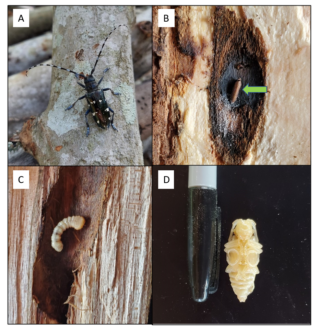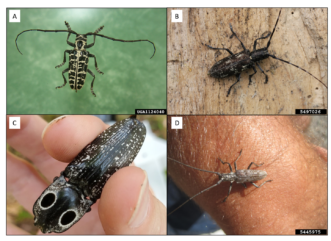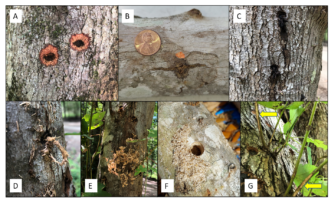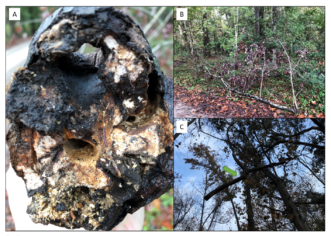The Asian longhorned beetle is a federally regulated invasive wood-boring pest recently discovered in South Carolina. This publication helps landowners and land managers know and recognize the most common signs of Asian longhorned beetle damage and what can be done if this pest is found.
Introduction
The Asian longhorned beetle (Anoplophora glabripennis, ALB) is an invasive, wood-boring beetle that originates from regions of Asia, including China and Korea, and has the potential to cause extensive damage to North American forests.1,2 ALB has been found in Illinois, New Jersey, New York, Massachusetts, Ohio, South Carolina, and Ontario, Canada. It was first intercepted in the United States in 1992 at ports in New York,3 and populations were considered to be established in 1996 in Brooklyn, New York. Other ALB populations were detected in Chicago, Ohio, Massachusetts, and Ontario, Canada.4,5,6 The most recent population discovered was in May 2020 in Charleston and Dorchester Counties in South Carolina.7 Management is challenging; however, efforts have been successful both in the United States and Canada. Asian longhorned beetle populations have been eradicated in several states, but efforts are still ongoing in parts of Ohio, Massachusetts, New York, and South Carolina.
Identification

Figure 1. Asian longhorned beetle life stages: (A) adult, (B) egg as indicated by green arrow, (C) larva, (D) pupa. Image credit: Meredith Bean, Clemson University (A) and Abby Ratcliff, North Carolina State University (B, C, D).
Asian longhorned beetles have a complete metamorphosis with four distinct life stages (figure 1). Adult ALB are black beetles between 1 and 1.5 inches long and have between ten and twenty white or yellow spots on their elytra (hard wing covers). They have long segmented antennae with white to bluish stripes. ALB eggs are about the size and color of a grain of rice. Grubs, although usually hidden beneath the bark or in the wood, are mostly white except for large, reddish-brown mandibles and can grow up to 2 inches long before pupating. Pupae are found within the sapwood and resemble adult beetles in structure, although their color resembles the larvae.
Several native beetle species can be mistaken for ALB (figure 2). Although similar in size and color, the cottonwood borer (Plectrodera scalator) contains much more white coloration on its body than ALB and lacks white bands on its antennae. The white-spotted pine sawyer (Monochamus scutellatus) is smaller than ALB, dull or bronzy black with white patches, and uses only conifers as hosts. The eastern eyed click beetle (Alaus oculatus) has two distinct black “eye spots” and lacks the long antennae characteristic of ALB. The northeastern sawyer (Monochamus notatus) is similar in size to ALB but is brown with no distinct spots.
Various ALB life stages cause different types of damage to trees (figure 3). Adult female ALB chew oviposition pits into the bark, into which they lay an egg. Oviposition pits generally appear as small, discolored, circular, or oval patches approximately 1 mm in depth and 15 mm in diameter.5 Oviposition pits get darker as they age. After the eggs hatch, larval feeding on phloem produces oozing or “bleeding” sap, which leaves dark streaks on the bark. Older larvae feed in the wood, resulting in wood shavings being pushed out onto tree bark or vegetation below the tree. One of the most obvious signs of ALB infestation is the circular exit holes (~1.5 cm in diameter) left by adult beetles emerging from the tree.3 Adults may feed on tender, green bark on young or epicormic shoots.

Figure 2. Asian longhorned beetle lookalikes: (A) cottonwood borer, Plectrodera scalator; (B) white-spotted pine sawyer, Monochamus scutellatus; (C) eastern eyed click beetle, Alaus oculatus; and (D) northeastern sawyer, Monochamus notatus. Image credit: Donald Duer, Bugwood.org (A); Steven Katovich, Bugwood.org (B); Lena Schmitt, Clemson University (C); and Rob Routledge, Bugwood.org (D).

Figure 3. Damage signs of Asian longhorned beetles: (A) new and (B) old oviposition pits, (C) streaking sap from early instar feeding in the phloem, (D) and (E) wood shavings made by older instar feeding in wood, (F) exit hole made by adult ALB leaving the tree, (G) adult feeding on young, epicormic shoots (as indicated by yellow arrows). Image credit: David Coyle, Clemson University (A), (C-E), and (G) and Meredith Bean, Clemson University (B).
Asian longhorned beetle is capable of infesting trees in twelve genera in North America, including Acer (maple), Populus (poplar and cottonwood), Betula (birch), Salix (willow), and Ulmus (elm) as preferred hosts.8 In the quarantined area of South Carolina, 98% of infested trees surveyed were Acer, with ALB secondarily infesting Salix, Ulmus, Platanus (sycamore), and Populus.7
Biology
Asian longhorned beetles spend nearly their entire life cycle as larvae, feeding on the inner wood of trees. Females chew oviposition pits in the bark of host trees, laying a single egg underneath the bark in each pit. ALB spend approximately their first three instars feeding on the tree’s phloem before tunneling into the inner wood of the tree and continuing to feed.3 The larvae overwinter in the inner wood and pupate in the spring in a cavity just under the bark. In late summer, emerging adults chew a circular exit hole before leaving to find a mate.
Adult beetles can disperse up to 2,600 meters to find new host trees but, on average, move only about 1 to 30 meters from the larval host tree before settling on a new host tree to find a mate and lay eggs.9 The mating process for ALB is not well understood but seems to involve a complex sequence of visual, chemical, and behavioral cues between partners.10 Thus, pheromone traps have been ineffective at detecting ALB invasions despite their successful use with similar invasive beetles.8
Asian longhorned beetles have varying life cycle lengths, depending on several factors, including climate and host quality. In the midwestern and northeastern United States, ALB can live anywhere from one to four years but can take up to a decade to mature in populations located in colder climates such as Finland.11 Models suggest beetle development could occur faster in the subtropical climates of the Deep South, potentially resulting in more than one ALB generation per year.12 However, this has not been observed in nature, and research in this area is ongoing.
Impact

Figure 4. Damage by Asian longhorned beetle larval feeding leaves large holes inside tree stems and branches (A), which can cause breakage (B) and hazardous conditions due to hanging branches or stems, indicated by the green arrow (C). Image credit: David Coyle, Clemson University.
ALB can cause significant damage to trees and associated economies, properties, and ecosystems.1 ALB larval feeding causes large tunnels in stems and branches, compromising structural integrity (figure 4) and enabling secondary infestation and damage by fungi, mold, or other wood-boring insects. While ALB larval feeding usually does not directly kill trees, it does weaken the structural integrity of branches and stems, causing the tree to break during wind, ice, or snowstorms.1 This can be particularly dangerous in urban and suburban areas, putting businesses, houses, and people at risk. Researchers estimated that, if left unchecked in the United States, ALB could cause up to $669 billion in terms of the lost value of trees and eradication costs and the death of up to 1.2 billion trees.1
ALB also causes problems by damaging hardwood trees and removing habitats and resources essential to other species. ALB’s potential impact on sugar maples and the maple syrup industry are of concern in the northeastern United States. In the eastern United States, red maples are commonly planted as shade trees, with nearly 1.8 million red maple trees sold (worth close to $75 million) by nurseries in the United States in 2017.13 Additionally, red maples are an early successional species inhabiting streamlines, rail and roadways, abandoned lots, and coastal areas after disturbance. Red maples serve essential ecological functions by contributing to the recovery of natural ecosystems and providing habitats and food to many organisms, including as an early-season forage for pollinators.14
Management
Eradication is the main goal in ALB-infested areas due to the severe economic and ecological impacts caused by the beetle. The Cooperative Eradication Program implemented by the US Department of Agriculture, Animal and Plant Health Inspection Service (USDA APHIS) includes surveying for infested trees, removal through cutting and chipping, and, in some cases, burning the wood chips.15 Surveys are typically conducted by ground crews using binoculars to evaluate trees for exit holes. Aerial surveys using bucket trucks, lifts, and tree climbers can also be necessary to observe canopies better. APHIS and state agencies have established regulated areas in ALB-infested regions, ranging from 137.3 km2 (53 mi2) in New York to 284.9 km2 (110 mi2) in Massachusetts. The current regulated area in South Carolina is 197.9 km2 (76.4-mi2), and the movement of host species or certain wood products from this area is prohibited as directed by the USDA Federal Order.
South Carolina presents new challenges to the eradication methods previously used. Low-lying wetlands and swampy conditions make surveying or getting equipment and workers to infested trees difficult. Dangerous wildlife, including alligators and venomous snakes, also pose a threat to ground crews.7 Due to these conditions, new eradication strategies are needed to overcome ALB infestations in this area.
ALB is a federally regulated species, and parts of Charleston and Dorchester Counties in South Carolina are under quarantine. The main goal is the eradication of this pest; therefore, management of already infested trees by property or landowners and landscape care professionals is discouraged. If you find an infested tree or see ALB, please capture the ALB and get it to a state or federal regulatory official, or take a picture and report it to Clemson University’s Department of Plant Industry ALB program by emailing stopalb@clemson.edu, uploading an image and location information to the South Carolina ALB Public Report Form, or calling (843) 973-8329.
Insecticides applied by licensed professional applicators may protect uninfested trees.5 Pyrethroids and carbaryl may be applied to the trunk of potential host trees to prevent oviposition by adults or kill young larvae that have hatched from the eggs. These insecticides must be applied to the trunk just before and throughout the flight period of the adults; however, ALB flight period information is currently unknown in South Carolina. In addition, trunk application of insecticides is ineffective against an established infestation. Prevention on uninfested host trees can also be achieved with one application of a systemic insecticide (such as dinotefuran, imidacloprid, and thiamethoxam) to the soil and root zone in the spring. However, previous studies indicate highly variable efficacy of the systemic insecticide application. Additionally, systemic insecticide labels typically include restrictions on application timing and frequency to protect pollinators, which frequent red maple blossom to gather pollen and nectar in early spring. The high cost and variable efficacy of insecticide treatment may not be feasible for large-scale preventive treatment against ALB.
References Cited
- Nowak D, Pasek J, Sequeira R, Crane D, Mastro V. Potential effect of Anoplophora glabripennis (Coleoptera: Cerambycidae) on urban trees in the United States. Journal of Economic Entomology. 2001 Feb;94(1):116–122.
- Dodds K, Orwig D. An invasive urban forest pest invades natural environments – Asian longhorned beetle in northeastern US hardwood forests. Canadian Journal of Forest Research. 2011 Aug;41:1729–1742.
- Haack R, Law K, Mastro V, Ossenbruggen H, Raimo B. New York’s battle with the Asian longhorned beetle. Journal of Forestry. 1997;95(12):11–15.
- Hopkin A, de Groot P, Turgeon J. Alien forest insects: what’s bugging us in Ontario? Emerald ash borer and Asian longhorned beetle. Forest Health and Biodiversity News. 2004;8:1–2.
- Meng P, Hoover K, Keena M. Asian longhorned beetle (Coleoptera: Cerambycidae), an introduced pest of maple and other hardwood trees in North America and Europe. Journal of Integrated Pest Management. 2015;6(1):4.
- Turgeon J, Gasman B, Smith M, Pedlar J, Orr M, Fournier R, Doyle J, Ric J, Scarr T. Canada’s response to invasion by Asian longhorned beetle (Coleoptera: Cerambycidae) in Ontario. The Canadian Entomologist. 2021 Jul;154(1):1–87. doi:10.4039/tce.2021.60.
- Coyle DR, Trotter RT, Bean MS, Pfister SE. First recorded Asian longhorned beetle (Coleoptera: Cerambycidae) infestation in the southern United States. Journal of Integrated Pest Management. 2021 Feb;12(1):10.
- Xu T, Teale S. Chemical Ecology of the Asian Longhorn Beetle, Anoplophora glabripennis. Journal of Chemical Ecology. 2021 Jun;47:489–503.
- Smith M, Tobin P, Bancroft J, Li G, Gao R. Dispersal and spatiotemporal dynamics of Asian longhorned beetle (Coleoptera: Cerambycidae) in China. Environmental Entomology. 2004;33:435–442.
- Graves F, Baker T, Zhang A, Keena M, Hoover K. Sensory aspects of trail-following behaviors in the Asian longhorned beetle, Anoplophora glabripennis. Journal of Insect Behavior. 2016 Oct;29:1–15. doi:10.1007/s10905-016-9587-8.
- Trotter R, Keena M. A variable-instar climate-driven individual beetle-based phenology model for the invasive Asian longhorned beetle (Coleoptera: Cerambycidae). Environmental Entomology. 2016 Dec;45(6):1360–1370.
- Kappel A, Trotter R, Keena M, Rogan J, Williams C. Mapping of the Asian longhorned beetle’s time to maturity and risk to invasion at contiguous United States extent. Biological Invasions. 2017;19:1999–2013.
- Census of Agriculture: 2019 Census of Horticultural Specialties. Washington (DC): United States Department of Agriculture, National Agricultural Statistics Service. https://www.nass.usda.gov/Publications/AgCensus/2017/Online_Resources/Census_of_Horticulture_Specialties/hortic_1_0022_0023.pdf.
- Abrams M. The red maple paradox: what explains the widespread expansion of red maple in eastern forests? BioScience. 1998 May;48(5):355–364.
- Haack R, Herard F, Sun J, Turgeon J. Managing invasive populations of Asian longhorned beetle and citrus longhorned beetle: a worldwide perspective. Annual Review of Entomology. 2010 Sep;55:521–546.
Additional Resources
Coyle DR. Asian longhorned beetle. Clemson Cooperative Extension, Home & Garden Information Center (HGIC); 2021. https://hgic.clemson.edu/factsheet/asian-longhorned-beetle/.

